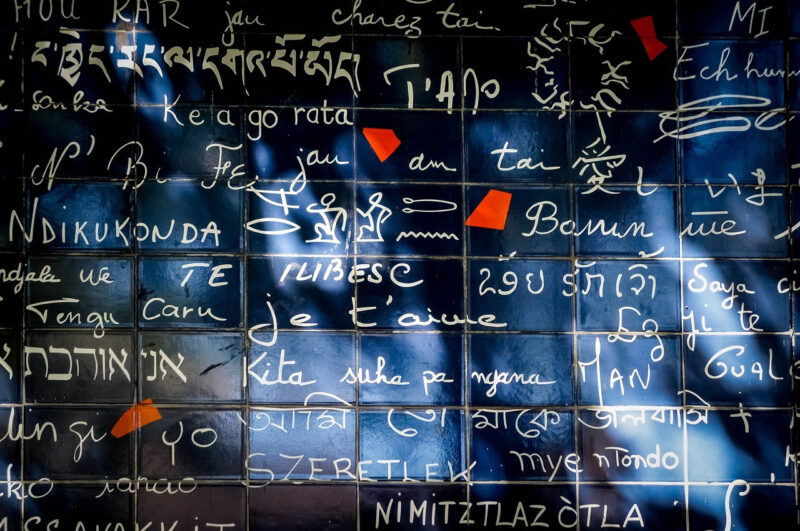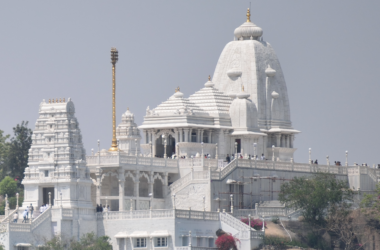Love is a universal language, one that transcends borders, cultures, and time. The Wall of Love, or “Le Mur des Je t’aime” in French, is a testament to this timeless sentiment. Located in the romantic heart of Paris, this unique landmark is a celebration of love, featuring the words “I love you” in over 300 languages. In this article, we’ll delve into the history, significance, and visitor experience of this beloved attraction.
History of the Wall of Love
The Wall of Love was created in 2000 by artists Frédéric Baron and Claire Kito. Baron, inspired by the idea of universal love, began collecting the phrase “I love you” in different languages. With Kito’s calligraphy skills, they transformed these expressions into a beautiful piece of art. The Wall was erected in the Jehan Rictus Square in Montmartre, an area already steeped in artistic history and romantic charm.
Location and Accessibility
Nestled in the Montmartre neighborhood of Paris, the Wall of Love is easily accessible by metro, with the closest station being Abbesses. This area is known for its bohemian vibe, with winding streets, charming cafes, and stunning views of the city. Whether you’re exploring Montmartre’s artistic legacy or seeking a quiet moment with your loved one, the Wall of Love is a must-visit.
Design and Structure
The Wall of Love is a striking piece of art, measuring 40 square meters and composed of 612 enameled lava tiles. The blue tiles provide a serene backdrop for the white inscriptions. The phrases, written in 311 languages, create a mosaic of love that invites visitors to find their own language among the many.
Messages of Love
Each tile of the Wall features the phrase “I love you” in different languages, from widely spoken ones like English and Chinese to lesser-known dialects. Some tiles also include Braille and sign language. Notable inscriptions include romantic languages like French and Italian, as well as heartfelt expressions from indigenous languages. This diversity underscores the Wall’s message of universal love.
Cultural Significance
The Wall of Love is more than just a tourist attraction; it is a symbol of peace and unity. It serves as a reminder that love transcends linguistic and cultural barriers. The Wall has become a beloved spot for both locals and tourists, a place where people can reflect on the power of love and human connection.
Visitor Experience
Visiting the Wall of Love is a unique experience. As you approach, you’ll see couples and families taking pictures, reading the inscriptions, and even leaving small tokens of affection. The area around the Wall is peaceful, offering a respite from the bustling city. The best times to visit are early morning or late afternoon when the light is soft and the area is less crowded.
Events and Activities
Throughout the year, the Wall of Love hosts various events, from poetry readings to music performances. On Valentine’s Day, the Wall becomes a focal point for celebrations, with couples from around the world gathering to express their love. Interactive activities, such as love note writing and art installations, often take place, making the Wall a lively and engaging spot.
Impact on Tourism
The Wall of Love is a significant draw for tourists, contributing to the vibrant atmosphere of Montmartre. Visitors come to experience the romantic charm of the area, often combining their visit with a tour of Montmartre’s other attractions. This influx of tourists has boosted the local economy, benefiting cafes, shops, and nearby attractions.
Wall of Love Around the World
Inspired by the Wall of Love in Paris, similar structures have sprung up in other cities worldwide. These walls, found in places like Tokyo, New York, and Berlin, echo the same message of universal love. Each wall adapts the concept to its cultural context, making the idea of a love wall a global phenomenon.
Preservation Efforts
Maintaining the Wall of Love is a community effort. Local organizations and volunteers regularly clean and restore the Wall to preserve its beauty. The Wall’s creators also remain involved, ensuring that this symbol of love continues to inspire future generations.
Personal Stories
Visitors often share touching stories about their experiences at the Wall of Love. From marriage proposals to reunions, the Wall has been a backdrop for countless memorable moments. These personal stories highlight the Wall’s impact on individual lives, making it a living testament to love.
Photography Tips
For those looking to capture the perfect photo, consider visiting during the golden hour when the light is soft and warm. Close-up shots of the inscriptions can create a meaningful image, while wider shots can capture the Wall’s full grandeur. Don’t forget to take a moment to step back and soak in the Wall’s beauty beyond the lens.
Nearby Attractions
Montmartre is rich with attractions. After visiting the Wall of Love, you can explore the Sacré-Cœur Basilica, the Dali Museum, or stroll through the charming Place du Tertre. A day in Montmartre offers a blend of culture, history, and romance, making it a perfect itinerary for any visitor.
Conclusion
The Wall of Love is more than just a wall; it is a celebration of the universal language of love. Whether you’re visiting Paris for the first time or you’re a seasoned traveler, the Wall offers a unique and heartfelt experience. As you stand before the Wall, reading “I love you” in so many languages, you’re reminded of the power of love to unite us all.
FAQs
What is the Wall of Love?
The Wall of Love, or “Le Mur des Je t’aime,” is a public art installation in Paris featuring the phrase “I love you” in over 300 languages.
Who created the Wall of Love?
The Wall was created by artists Frédéric Baron and Claire Kito in 2000.
Can I write my own message on the Wall?
No, the Wall is a fixed art installation. However, visitors are welcome to leave small tokens or notes nearby.
How do I get to the Wall of Love?
The Wall is located in the Montmartre neighborhood, near the Abbesses metro station.
Are there any other Walls of Love in different countries?
Yes, inspired by the Parisian Wall of Love, similar installations can be found in cities around the world, each celebrating the universal theme of love.









